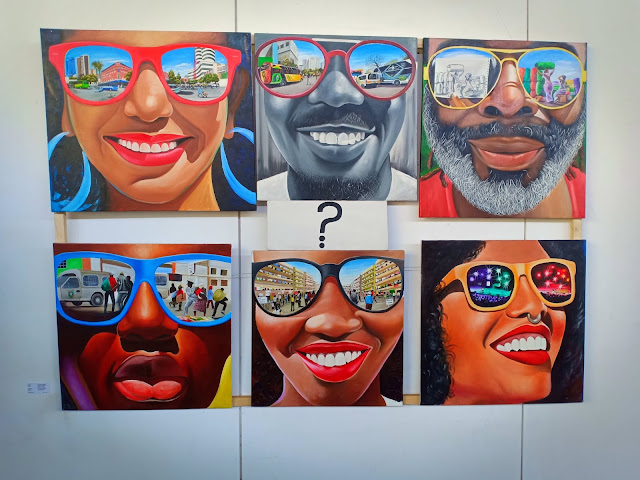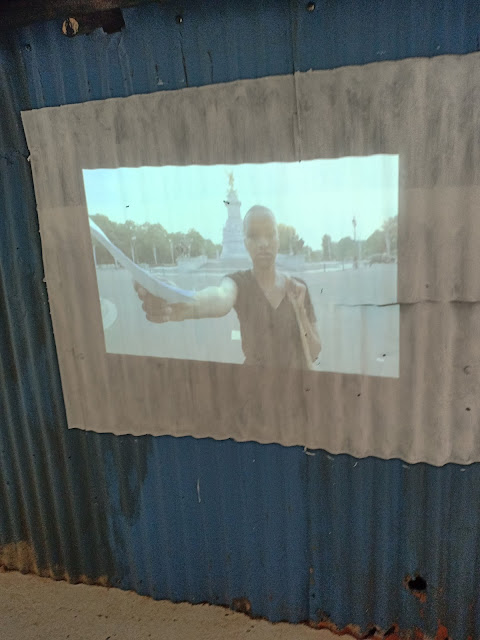By
Margaretta wa Gacheru (posted 29 March 2019 for BD Life)
When Mutuma Murangu
isn’t trading in commodities, he’s pioneering on the cutting edge of art
collecting in Kenya.
Specializing
in stone, Mutuma is hardly a household name in the Kenyan art world. Indeed, he
only started exhibiting part of his large collection of stone sculptures last
year at the Nairobi National Museum. Yet the moment he put up Robin Mbera’s
impressive exhibition of 26 commissioned (by him) Kisii stone sculptures
entitled ‘Afro-Cubism Journey #1’ at the Museum, Mutuma became an inspiration
and de facto spokesman for Kenyan art collectors.
That’s one
reason he was invited to the Windsor Hotel to share his insights as a collector
during the two-day ‘Art and Finance Conference’ organized by Art at Work CEO
Roy Gitahi who is also Chair of the Wabuni Sacco.
Roy Gitahi, CEO of Art@work and organizer of Art & Finance Conference
Roy Gitahi, CEO of Art@work and organizer of Art & Finance Conference
“I see art
very much like land,” says Mutuma who only started collecting art in 2006.
“Both are finite in the sense that there is only so much good art and good
land. But both have immense investment potential,” he adds.
The value of
art isn’t only measured by its investment potential, according to Dr. Fred
Scott, an experienced fine art consultant from South Africa who explained on Day
One of the conference that art’s value is both aesthetic and economic.
The economic
aspect of art collecting was the main focus of the conference, as was shown in
the subtitle of the conference which read: ‘Art as a viable and sustainable
investment.’
In this
regard, Scott gave a brief history of the global art market which in 2018 had
risen to nearly USD67.4 million according to the annual Deloitte Art and
Finance Report which keeps a running tally on the financial value of art in its
global wealth portfolio. Dr Scott noted that 84 percent of that USD67.4 million
had been transacted in just three countries, the US, UK and China. He added
however that the African art market has immense investment potential. But both
Scott and Mutuma agreed that the importance of growing not just good African
artists but also committed collectors of African art as well.
Dr Scott
noted that there can be risks involved in buying any fine art. The art could
have been stolen; it might also be a fake. And finally, there’s always the risk
of overpaying for an artwork that isn’t very ‘good’, meaning it could diminish,
not accrue in value over time.
Scott cited
a painting by the American painter, Parker Ito who sold his painting in what he
called an ‘overheated art market’ at a Sotheby’s auction in 2011 for USD47,000.
But by 2017 the resale of that same piece on the secondary market had plunged
to only USD4,800.
But Dr Scott
also recalled that the most expensive artwork in the world, by Leonardo da
Vinci (‘Salvator Mundi’) sold for a record-breaking USD450.3 million
(USD450,315,500) at Christie’s Auction House in 2017. It had been bought by the
Louvre in Abu Dhabi.
In order to
know how much to pay for a piece of art, Scott said that research is essential
as is knowing the provenance (or origin) of an artwork.
Unfortunately,
he said the value of the global art market is measured by figures derived from
annual sales at auction houses, galleries and even art fairs. “That is why I
advise young artists to get into art auctions as soon as possible, since those
recorded figures provide a benchmark for collectors who might be interested in
buying your art.”
 He added
that even if the sale of an artwork is relatively low at auction, a prospective
buyer will know they are likely to pay more than the online figure.
He added
that even if the sale of an artwork is relatively low at auction, a prospective
buyer will know they are likely to pay more than the online figure.
Dr Scott and
Mutuma both used pie charts to break down the figures. Scott noted that out of
the USD67.4 billion, some USD 29.18 billion derived from auction sales. Then
Mutuma said that the subsection of the global art market that interests him
most measures post-colonial sales which amounted to USD7.28 billion sales in
2018. And in relation to Kenya, that includes artworks made post-1963.
“Our Kenyan
art market is still in its infancy,” says Mutuma who has no doubt that growth
in that market is bound to experience what he called a ‘cross-over moment’ when
the measurement of Kenyan art’s value explodes.
But for now,
he concurs with Conference founder Roy Gitahi, that art institutions need to be
both established and strengthened. Roy established the Wabuni Sacco to address
the various financial constraints that local artists often face. Negotiating
with financial institutions like Stanbic Bank, he says he understands artists
often don’t have access to credit because they don’t have consistent salaries.
But he hopes to see creatives’ artworks serve as an alternative form of
collateral so they can access not only credit but even insurance, pension plans
and other financial services that Stanbic already provides to SMEs.
First Lady Margaret Kenyatta painting at Conference
First Lady Margaret Kenyatta painting at Conference
“Negotiations
have begun with Wabuni, but they have not yet been finalized,” says Ken Gitau,
Stanbic manager in charge of workplace banking. Nonetheless, Roy has the vision
of Wabuni’s Sacco as enabling artists to not only have access to bank credit
through its partnering with financial institutions. He’s even proposing that
Kenyan artworks can eventually be traded on Nairobi’s Securities Exchange.
The reason
he feels so passionate about Wabuni is because he says it fits into his wider
concern that art infrastructures need to be built and strengthened as means of
growing the Kenyan art market and establishing its place in the global art
arena as well.
The one
obvious shortcoming of this Art and Finance Conference was the absence of
Kenyan artists. Only two were present. One was Swift the graffiti artist who
had created the artwork given to the First Lady Margaret Kenyatta by Roy Gitahi
in appreciation for her presence at the Conference. She was accompanied by the
CS for Culture, Arts and Sports, Ambassador Amina Mohamed and the Principal
Secretary for Culture and Heritage, Ms Josephta Mukobe. The other artist was
Robin Mbere whose Afro-Cubist sculpture was exhibited at the conference.
Elephant by First Lady Margaret Kenyatta painted in 3 minutes





















































